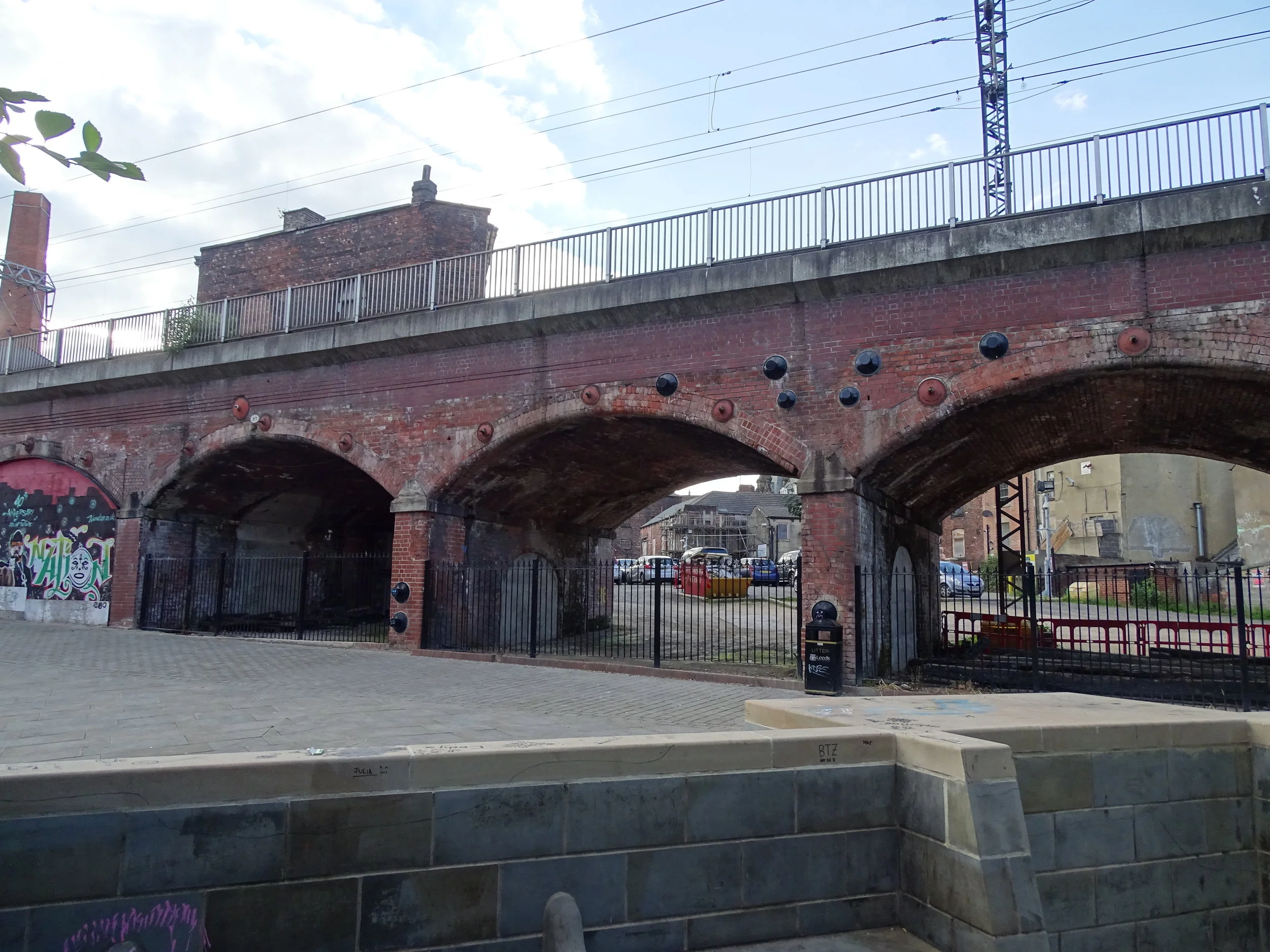This was largely written late afternoon on 31st August on a train speeding north towards Edinburgh. I change there for Dundee shortly after 6. I got tied up reviewing the new Highways England code for bridge assessment CS 454 which was issued in June. Can I just say I found it disappointing? I will post the review soon. This BoM looks like being late!
Today, I promised a look at Marsh Lane Viaduct. I will start with a casual mention of a possible link between the name and the quality of the foundations. The viaduct was built to link Leeds’ first rail link, the Leeds and Selby line ad it’s terminus at Quarry Hill and the Leeds and Manchester line which terminated a what is now Leeds City Station. There are about 70 spans and I haven’t done more than glance at many of them. Today we are looking around here.
As usual, there is a pdf version to download here.
I first got involved as a result of some strange movement in spans 30-31. It is still happening and is in a publicly accessible place. This video was taken in spring 2019.
Those spans have now been filled with concrete and so are inaccessible, even if they weren’t tenanted, as they were before the movement was spotted.
I will concentrate today on span 38 because it is still accessible and I was able to get in and photograph it (rather hurriedly) and make a model, which makes it much easier to illustrate. Hamish had previously made a similar model of span 36 and I will refer to that too.
Marsh lane is where I first began to understand how badly I had misjudged the likely behaviour of viaducts. Let’s run through some of that before getting into detail. Piers certainly rock back and forth along the line of the viaduct as trains pass over. The mechanism driving that is very different from what I thought for 30 years. They also rock sideways (not a surprise if you give it any thought at all). That rocking compacts the soil in the foundation more around the edge than in the middle and the whole thing ends up sitting on a shallow dome. Interesting. The effect when you split the pier into two legs is dramatic and largely unconsidered. We worry about the top but not the bottom.
However, let’s begin with a look at the top of the piers in span 38.
The V in that string course/ skewback is unmistakeable.
Looking up from below we can see cracks working up from the middle of each side. North is at the bottom of this picture and East to the right. There is lots more to see here but we will (I hope) come back to it.
Looking at the north elevation I can begin a description of the construction.
It’s a fairly “ordinary” viaduct. Modest spans of about 25.75ft and looks like 1:5 span to rise ratio, a 4 brick ring springing from local gritstone skewbacks. There are elegant corbels supporting a parapet and refuges.
If we zoom in and tilt a little, we can see the short cuts the bricklayers took.
Those bricks are laid frog down. Quicker and easier to lay but much weaker. The parapet is effectively cantilevered over the edge of the bridge proper. It was never intended to contain trains but to provide a measure of fall protection for workers. Notice, too, that even the replacement brick is hanging over the edge of the arch.
Look back at the elevation and notice the strange positions of the older ties. Look at the South side and we can be sure they were drilled from there.
Evenly spaced neatly positioned 1 ring down from the top. Construction at the top here is not so clear because I had to walk some distance round to get these pictures and was running out of time. You can see, though, that the top has been completely reconstructed with a concrete cantilever. I presume that the track has been hung somewhat over this side to mitigate the curve but what other effects might that have.
Looking at a pier face is educational.
Looks a bit of a mess, doesn’t it. The skewbacks over the arch look loose. There is a lot of patching, a concrete plug and tie bars through below the arch. It’s even more brutal if you look closer.
There’s a crack going up into the main arch. The “relieving” arch has dropped rather than cracking but a lot of load is concentrated on the inside face of those legs and I don’t think the repairs will have done much to improve that. Notice at the right how the face has spit clean off and at the left how there is a large patch of new brickwork which must be carrying serious load because the second brick up is split through.
Looking the other way there is less distortion, but it is still significant. The south (right) elevation of the pier has been completely reskinned apparently without any attempt to bond the work in. Part of that joint is hidden by the much newer fence.
Along at span 36, which is a public path, the construction is somewhat different.
Here, the relieving arch reaches up through the skewbacks. Because everything above that line is so solid, the crack from the crown of the relieving arch is coupled with the whole bridge above the skewback doing the splits and the load sits on the inside edge while the outer edges float free.
You can see that movement in the video above.
This is the model from which the above photo is taken.
And if you have any doubts about the foundations breaking their back have a look at this model of a pier of Balcombe Viaduct. Sight along the courses just below the invert of the relieving arch.
And I think that is enough for now. Hope to be on time next month.










